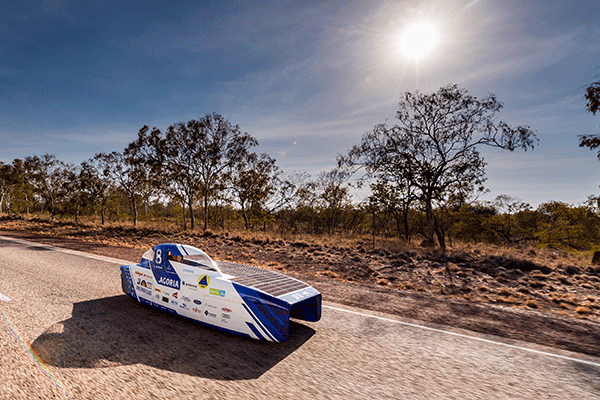The eagerly awaited battery revolution
The rapid growth of renewable energies must go hand in hand with the wide-scale deployment of electricity storage solutions. Current technologies are efficient, but still insufficiently so: research is working fast to remedy this situation.
Written by:
Rafael Jahn, ENGIE Laborelec.
Dominique Corbisier, ENGIE Laborelec.
Paulo Torres, ENGIE.
Read the PDF article here
Special issue in partnership with ENGIE Research
April 2020

Princess Elisabeth Antartica, Belgium’s polar research station.
Anchored on a rocky outcrop, this Belgian polar research station is like no other: thanks to its photovoltaic and thermal panels, complemented by nine wind turbines, Princess Elisabeth Antarctica (inaugurated on February 15, 2009) runs entirely on renewable energies. Such a feat wouldn’t have been possible without the batteries that enable the station to store electricity and manage the intermittent supply of power.
And it is a fact that such measures will be essential in the transition toward a carbon-neutral world, a process that will see a significant increase in renewable energy sources, whose intermittent nature will exceed the limits of the power grid’s current capacity to balance supply and demand, at least locally. Intermittency is a more complex character to manage than we think. Today the grid’s network of conventional, interconnected power plants and power reserves are largely sufficient to allow the grid operator to compensate for short periods of intermittency (from one second to a quarter of an hour). The question arises however for longer periods, such as a few hours during which clouds disrupt solar power production, at night, or on days with neither wind nor strong sunshine. Increasing power reserves by keeping a higher number of conventional power plants on stand-by cannot be the only solution.
COMPENSATING FOR INTERMITTENCY
Ideally, as the world advances down the road to zero emissions, we need cheap, safe and performant storage solutions to compensate for both fast and slow fluctuations, encourage the development of local energy and microgeneration, provide non-carbon-based means of grid balancing and to massively store electricity to allow the dispatchable supply of green electricity. To meet this array of needs, battery storage has an important role to play, but several obstacles remain to be overcome.
Today’s battery energy storage systems are mainly based on lithium-ion technology. Although this technology is mature, industrial processes are perfectible, which underlines the importance of developing our practical experience of this type of battery. ENGIE works at overcoming the technological and operational obstacles that are slowing down its development. Areas of research include battery cell ageing, how to save the entire energy storage system, repurposing EV batteries for stationary energy storage, and ways of controlling both “fleets” of batteries and single units.
For some uses, however, such as mass or seasonal energy storage, lithium-ion technology will not always be the best, nor the most affordable solution. Today, providing a satisfactory amount of electrical power (measured in watts) is relatively cheap, but this is not the case for electrical energy (watt-hours). Other technologies are therefore indispensable and several are already the subject of major development efforts. In addition to performance, it is hoped to improve safety and reduce costs. Lithium-sulphur, redox flow, solid electrolyte, sodium-ion, and metal-air batteries are all currently being evaluated and tested by ENGIE in the laboratory, or even as part of demonstration projects. Some of these technologies provide longer life, lower costs and a more sustainable life cycle when compared to the current technologies, which are simply paving the way. Will the road be long?
A VICTORY IN THE SUN
The team that won the 2019 edition of the World Solar Challenge (the “Solar Vehicle World Cup”) in Australia illustrated this maxim by putting their trust in ENGIE to advise them. To stand a chance of claiming victory, you need an energy-efficient vehicle, good onboard solar energy production and a battery whose characteristics are well known. Next it is important to make the best use of the battery depending on the headwind, the terrain and the temperature, without running out of power in view of the finish line, but also without leaving too large a safety margin.
Thanks to ENGIE’s Storage Lab, which tested the would-be cells and provided advice on their implementation, the winners were able to count on a homogeneous battery pack in which no cells were overused. Information was available at all times about the battery state of charge and they could optimise the batteries before each stage of the race. This precise energy management was decisive.

LITHIUM-ION IN THE ANTARCTIC ?
In 2008, ENGIE installed the batteries at Princess Elisabeth Antarctica. These lead-acid batteries with a gel electrolyte (instead of liquid so the batteries don’t have to be kept upright) are in fact based on century-old technology. It was no easy task to manually handle tons of material in the extreme cold, but it all worked out fine and, as soon as it was put into service, the zero-emissions base was able to count on a total energy output of 400 kilowatt hours.
“For some uses, lithium-ion technology will not always be the best, nor the most affordable solution.”
At that time it was still too early to consider using lithium-ion batteries, although for Antarctica, as for space applications, price was not the major constraint. The main factor was knowledge gained from experience in terms of battery lifetime in such a harsh environment and even more so in terms of safety. Today, more than 40 years after taking their first steps, lithium-ion batteries have finally found their place in mobile and mobility applications where battery size and weight are key. For stationary applications on the other hand, these constraints are less important and it should be possible to opt for a technology that uses more common, less controversial, and therefore theoretically even cheaper materials.
Will it take another four decades to replace lithium-ion? Probably not, but at least a decade will have to pass before the right substitute is discovered and improved. Circumspection will be the order of the day: seeing the sheer quantity of research in this field, the search for funding may well give rise to a good number of announcements of “sensational results”, which will finally be unconfirmed and likely to sow doubt.
In the meantime and despite the imperfections of lithium-ion, efforts continue to perfect their integration with the end-user, in the grid and in areas that have not yet been electrified. An ambitious programme that is rapidly becoming a reality.